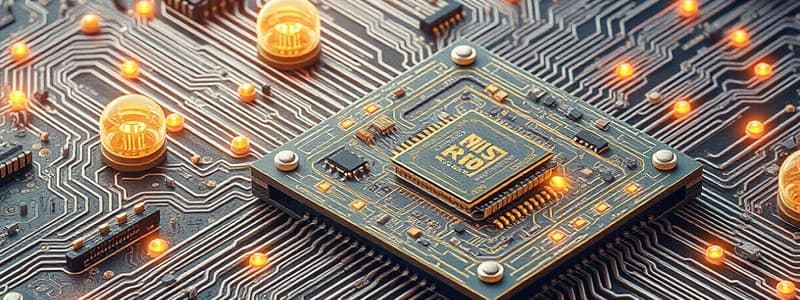Podcast
Questions and Answers
What characterizes intrinsic semiconductors?
What characterizes intrinsic semiconductors?
- They have a pure form and their conductivity increases with temperature. (correct)
- They only exist in solid form.
- They are doped with impurities to enhance conductivity.
- Their conductivity decreases with temperature.
Which properties are crucial for defining a semiconductor's electrical behavior?
Which properties are crucial for defining a semiconductor's electrical behavior?
- Temperature and pressure.
- Resistance and capacitance.
- Conductivity and magnetic field strength.
- Band gap and doping. (correct)
What is the primary function of diodes in electronic circuits?
What is the primary function of diodes in electronic circuits?
- To amplify signals.
- To control the conduction of electrons.
- To allow current to flow in one direction. (correct)
- To create holes in a semiconductor.
What distinguishes n-type semiconductors from p-type semiconductors?
What distinguishes n-type semiconductors from p-type semiconductors?
Which of the following is a type of Field Effect Transistor (FET)?
Which of the following is a type of Field Effect Transistor (FET)?
What is a significant advantage of using integrated circuits (ICs) in electronic devices?
What is a significant advantage of using integrated circuits (ICs) in electronic devices?
Which application does NOT commonly use semiconductor devices?
Which application does NOT commonly use semiconductor devices?
What is the role of boron when used as a dopant in semiconductors?
What is the role of boron when used as a dopant in semiconductors?
Flashcards are hidden until you start studying
Study Notes
Semiconductor Devices
Definition
- Materials with electrical conductivity between conductors and insulators.
- Essential for modern electronics, enabling control of electrical current.
Key Properties
- Band Gap: Energy difference between the valence band and conduction band; determines electrical properties.
- Doping: Introducing impurities to modify electrical properties (n-type and p-type).
Types of Semiconductor Materials
-
Intrinsic Semiconductors
- Pure form; conductivity increases with temperature.
- Examples: Silicon (Si), Germanium (Ge).
-
Extrinsic Semiconductors
- Doped with impurities to enhance conductivity.
- N-type: doped with elements like Phosphorus (P) adding extra electrons.
- P-type: doped with elements like Boron (B), creating holes (positive charge carriers).
Key Semiconductor Devices
-
Diodes
- Allow current to flow in one direction; used for rectification.
- Types:
- Silicon Diodes
- Zener Diodes: allow reverse current under specific voltage (voltage regulation).
- Light Emitting Diodes (LEDs): emit light when current passes through.
-
Transistors
- Act as switches or amplifiers; crucial in digital circuits.
- Types:
- Bipolar Junction Transistor (BJT): uses both electron and hole charge carriers.
- Field Effect Transistor (FET): controls current by an electric field; includes MOSFET (Metal-Oxide-Semiconductor FET).
-
Integrated Circuits (ICs)
- Combination of multiple semiconductor devices in a single package (e.g., microprocessors).
- Allows miniaturization and increased functionality.
Applications
- Computers: Processors and memory chips.
- Communication: Signal amplification and modulation.
- Power Electronics: Conversion and control of electrical power (e.g., inverters, converters).
- Sensors: Temperature, light, and pressure sensors.
Advantages of Semiconductors
- Small size and low weight.
- High efficiency and reliability.
- Versatility in various applications.
Challenges
- Temperature sensitivity affecting performance.
- Fabrication complexity and cost.
- Need for thermal management in high-power applications.
Semiconductor Devices
Definition
- Semiconductors are materials with conductivity between conductors and insulators, crucial for controlling electrical current in electronics.
Key Properties
- Band Gap: Indicates the energy difference between the valence and conduction bands; crucial in determining a material's electrical properties.
- Doping: The process of adding impurities to semiconductors to alter their electrical conductivity, resulting in n-type (negative charge carriers) and p-type (positive charge carriers) materials.
Types of Semiconductor Materials
-
Intrinsic Semiconductors:
- Pure forms that increase conductivity with rising temperature.
- Common examples include Silicon (Si) and Germanium (Ge).
-
Extrinsic Semiconductors:
- Modified by the introduction of impurities to enhance conductivity.
- N-type semiconductors: Doped with elements like Phosphorus (P), adding more electrons.
- P-type semiconductors: Doped with elements like Boron (B), creating holes that act as positive charge carriers.
Key Semiconductor Devices
-
Diodes:
- Components that allow current to flow in a single direction; essential for rectification.
- Includes:
- Silicon Diodes for standard applications.
- Zener Diodes that permit reverse current at specific voltages for voltage regulation.
- Light Emitting Diodes (LEDs) which emit light when current flows through.
-
Transistors:
- Functions as switches or amplifiers; integral in digital circuits.
- Types include:
- Bipolar Junction Transistor (BJT): Utilizes both electrons and holes.
- Field Effect Transistor (FET): Employs an electric field to control current, including variants like MOSFET (Metal-Oxide-Semiconductor FET).
-
Integrated Circuits (ICs):
- Comprise multiple semiconductor devices in one package, such as microprocessors, enabling miniaturization and enhancing functionality.
Applications
- Computers: Fundamental in processors and memory chips for data processing.
- Communication: Essential for amplifying and modulating signals.
- Power Electronics: Key in controlling and converting electrical power, including use in inverters and converters.
- Sensors: Widely used in devices measuring temperature, light, and pressure.
Advantages of Semiconductors
- Compact size and lightweight nature promote integration into various technologies.
- High efficiency and reliability contribute to their widespread use.
- Versatile applications across different fields enhance technological advancements.
Challenges
- Performance can be sensitive to temperature variations, impacting functionality.
- The complexity and cost of fabrication pose significant hurdles.
- High-power applications require effective thermal management to ensure device longevity and performance.
Studying That Suits You
Use AI to generate personalized quizzes and flashcards to suit your learning preferences.




